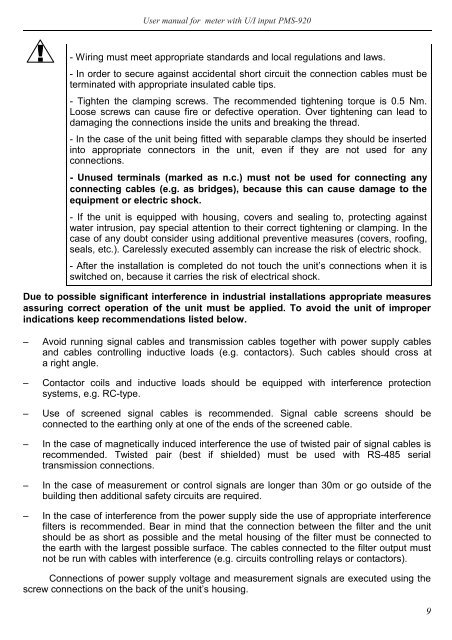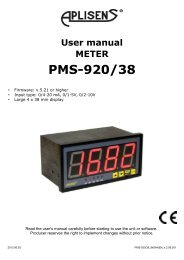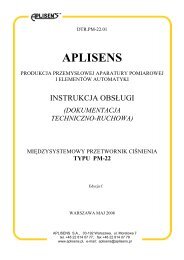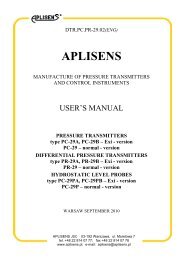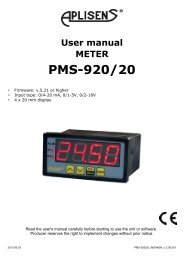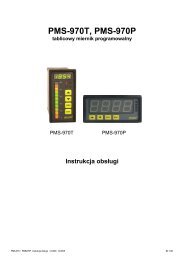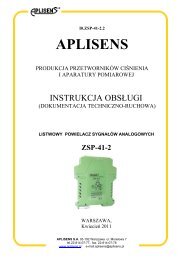PMS-920 - Aplisens SA
PMS-920 - Aplisens SA
PMS-920 - Aplisens SA
You also want an ePaper? Increase the reach of your titles
YUMPU automatically turns print PDFs into web optimized ePapers that Google loves.
User manual for meter with U/I input <strong>PMS</strong>-<strong>920</strong><br />
!<br />
- Wiring must meet appropriate standards and local regulations and laws.<br />
- In order to secure against accidental short circuit the connection cables must be<br />
terminated with appropriate insulated cable tips.<br />
- Tighten the clamping screws. The recommended tightening torque is 0.5 Nm.<br />
Loose screws can cause fire or defective operation. Over tightening can lead to<br />
damaging the connections inside the units and breaking the thread.<br />
- In the case of the unit being fitted with separable clamps they should be inserted<br />
into appropriate connectors in the unit, even if they are not used for any<br />
connections.<br />
- Unused terminals (marked as n.c.) must not be used for connecting any<br />
connecting cables (e.g. as bridges), because this can cause damage to the<br />
equipment or electric shock.<br />
- If the unit is equipped with housing, covers and sealing to, protecting against<br />
water intrusion, pay special attention to their correct tightening or clamping. In the<br />
case of any doubt consider using additional preventive measures (covers, roofing,<br />
seals, etc.). Carelessly executed assembly can increase the risk of electric shock.<br />
- After the installation is completed do not touch the unit’s connections when it is<br />
switched on, because it carries the risk of electrical shock.<br />
Due to possible significant interference in industrial installations appropriate measures<br />
assuring correct operation of the unit must be applied. To avoid the unit of improper<br />
indications keep recommendations listed below.<br />
– Avoid running signal cables and transmission cables together with power supply cables<br />
and cables controlling inductive loads (e.g. contactors). Such cables should cross at<br />
a right angle.<br />
– Contactor coils and inductive loads should be equipped with interference protection<br />
systems, e.g. RC-type.<br />
– Use of screened signal cables is recommended. Signal cable screens should be<br />
connected to the earthing only at one of the ends of the screened cable.<br />
– In the case of magnetically induced interference the use of twisted pair of signal cables is<br />
recommended. Twisted pair (best if shielded) must be used with RS-485 serial<br />
transmission connections.<br />
– In the case of measurement or control signals are longer than 30m or go outside of the<br />
building then additional safety circuits are required.<br />
– In the case of interference from the power supply side the use of appropriate interference<br />
filters is recommended. Bear in mind that the connection between the filter and the unit<br />
should be as short as possible and the metal housing of the filter must be connected to<br />
the earth with the largest possible surface. The cables connected to the filter output must<br />
not be run with cables with interference (e.g. circuits controlling relays or contactors).<br />
Connections of power supply voltage and measurement signals are executed using the<br />
screw connections on the back of the unit’s housing.<br />
9


